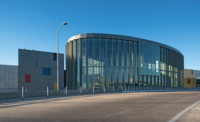Over the last 20 years, Laredo International Airport in Texas has secured $200 million in funding for a long list of projects—perhaps unexpected for a non-hub, primarily cargo airport. But the work is growing out of a specific approach to funding that is allowing the projects to get underway.
“We get $1.7 million a year in just entitlements, which means that money comes from the passenger activity and cargo activity,” explains Guillermo Villalobos, airport operations manager for Laredo International. “The funding level that we’re looking at actually requires quite a bit more federal funding, which comes from the discretionary pot from the [Federal Aviation Administration]. That’s the challenging part of it because to get all the money to do the projects we’ve done requires attention to a lot of detail.”
The airport’s master plan addresses a series of capital improvement projects out 20 years in five-year increments: for 2015-20, about 27 projects for $82.2 million; for 2020-25, about 16 projects for $180.3 million; and for 2025-35, about five projects for $139.3 million.
In 2014, the airport started seven projects ranging from $400,000 to $5.2 million, totaling $9.5 million. These jobs included fence replacement, chiller replacement, baggage system improvements, Phase 8 of apron reconstruction and rehabilitation, a security system and parking lot improvements.
“With such a large scope, it required the critical performance on the part of the engineers to get the design done and meet all the scheduling dates so that we could secure the funding for all the projects,” Villalobos says. “Airport construction is very complex, it’s not typical road construction. You have horizontal and vertical surfaces to protect.”
“Here at Laredo there is a lot of support from the city, and you don’t necessarily see that at all airports,” says Chad Pennel, senior project manager with Lockwood, Andrews & Newnam Inc. (LAN), which has been assisting the airport with its aggressive project execution strategy for the last two and a half years. “One thing they do a very good job of is funding design projects with local funds and getting those projects designed and ready to go and really positioning themselves to take best advantage of discretionary funding from the FAA. But not all airports are this size and not all have done that. There is some risk there to fund that design fee because they’re not 100% positive that the design project is going to turn into a construction project.”
Cost estimating has been crucial. The FAA has been asking for overall development objectives (ODOs) to justify the projects, Pennel says. “Part of preparing some of those ODOs for some of our paving projects, we actually had to go out and do pavement surveys to obtain a [pavement condition index] in order to provide additional justification for some of our paving projects.”
Much of Laredo’s traffic is cargo based. That means a tremendous number of heavy aircraft are using the airport’s infrastructure.
Laredo was built by the Air Force during World War II as a base, but the pavement was designed for the light T-38s—“it was the primary trainer aircraft here at Laredo,” Villalobos says.
That history means that the pavement at Laredo was originally around 7 in. thick. However, heavy planes such as the Airbus 300, 727s, DC-9s and MD-80s are going in and out multiple times a day, creating a need for stronger pavement infrastructure. Paving projects going on right now will dramatically increase the durability and thickness of the runways and aprons around the airport, Villalobos explains.
“We’re putting in pavement structure that consists of 17 inches of Portland cement concrete (PCC) on 6 inches of asphalt over subgrade,” Villalobos says.
Complex Master Plan
Approximately 50 projects are outlined in the airport’s master plan, totaling nearly $400 million. By breaking the projects up into a smaller series, the airport ensures that the work will be both fully funded and completed.
In November 2015, Reim Construction Inc. began work on the next project in the lineup, the Taxiway G Reconstruction—an $8.3-million, full-length parallel runway on the west side of the airfield, which is where most of the cargo traffic arrives.
“We have to be aggressive in getting these projects done and finished.”
—Guillermo Villalobos, Airport Operations Manager, Laredo International Airport
“We’ve already got a full-length parallel on the east side of the airport,” Pennel says.
The extension was supposed to be done first, but planners determined that the Taxiway G pavement section couldn’t handle the increased number and type of aircraft that would be using the taxiway after its full length is in place, Pennel explains. As a result, the reconstruction had to be done first.
Construction on the extension should begin later this year. Project phasing is helping to minimize closure time on Laredo’s runway 14/32. “At the south end of Taxiway G, the keel section was reconstructed of 15 inches of PCC as part of a previous project,” Pennel says. “The 12.5 feet on either side of the keel section is being reconstructed as part of this project to make sure the full 75-foot width is constructed with pavement adequate for the anticipated number and type of aircraft operations.”
With so much new paving at Laredo Airport, “sometimes getting hold of bituminous materials, P-401 or P-403, that are required on airport projects can be a challenge—if you have asphalt plants that don’t want to produce it,” Pennel notes.
Marco Martinez with Reim Construction says “right now we only have one plant that provides materials for the area, so sometimes that becomes a challenge for us, but it’s a matter of scheduling.”
Follow-up projects are planned that will solve issues such as those presented by an FAA advisory circular on airport geometry, requiring changes in airport design. For example, taxiways must no longer connect an apron to a runway, so after Taxiway G and the series of apron reconstructions are complete, additional projects will reroute taxiways that are not in compliance with the FAA’s advisory, Pennel notes.
“When you maintain a level of activity and progress and efficiency, then the FAA rewards you with funding because they know you’re going to put it to good use. The money doesn’t sit around and collect dust so to speak,” Villalobos says. “So we have to be shovel ready. We have to be aggressive in getting these projects done and finished.”






Post a comment to this article
Report Abusive Comment